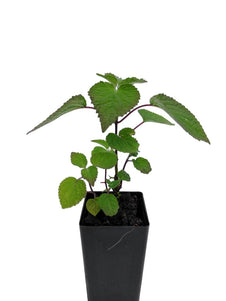
Salvia 'Blue Bird'
Salvia 'Blue Bird'

- Low stock - 8 items left
- Inventory on the way

Usually available: All year
Life cycle: Perennial
Height: 1.8 - 2.5m
Position: Sun / part shade
Soil preference: Well drained
This is how we pack and send your Herb Plants to all states except TAS & WA
You will receive
- 1 Salvia Bluebird Herb Plant in a 50 X 75mm tube - General growing instructions
All of our Herb Plants are grown organically with certified organic potting mixes and fertilizers
Botanical Name:
Salvia Blue Bird is a tall salvia reaching 1.8 meters, with some reports of up to 3 meters. It has an upright habit, but the tall stems may arch over. The heart shaped leaves are large and quite a bright mid green, sometimes appearing yellow-green. The leaves are well textured, with obvious veins following the natural curve, eventually to the tip of the leaf.
The autumn and winter flowers take on a dense brush like appearance, high on the shrub. They have the furry or hairy calyces common to salvia, this time a soft grey-green colour. However, the real feature is the little blue bird that is found in the small flower’s side profile. The delicate lobed wings fan down and out to the sides, low, as if just before being lifted high once again. Choose just the right angle and you will see the deep blue eyes painted on the tiny face, with a perfectly positioned tiny beak to complete nature’s own artistry.
The origins of salvia Blue Bird are unknown, with its appearance in Australasia becoming part of local salvia folklore. The plant seems to have been part of a shipment from the USA marked ‘unknown salvia’ some years ago. There is limited information available about the plant’s history, but Blue Bird is an apt name. Expert speculation has suggested that potential parent plants for this likely hybrid may be S. polystachya or S. purpurea.
Growing Conditions
Salvia Blue Bird occasionally sets seed, however vegetative propagation is also possible by taking cuttings at the right time of year. It is suitable for container planting, although it is a large plant.
The salvia family has over 900 members with an extensive history as culinary, medicinal and ornamental plants. Ornamental salvias have become collectors items, as gardeners try to find a place in their garden for each and every one. There are salvias that will suit every type of soil and climate. More information on the Salvia genus and Common Sage (Salvia officinalis) may be found on our Common Sage page.
All information provided on this website is for informational purposes only. Please seek professional advice before commencing any treatment.





